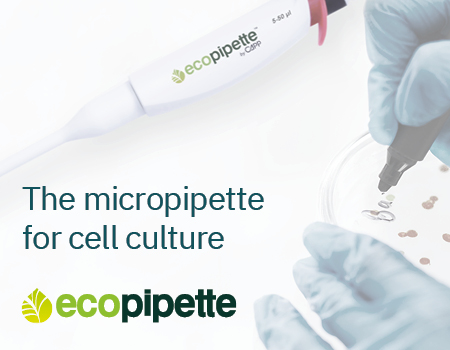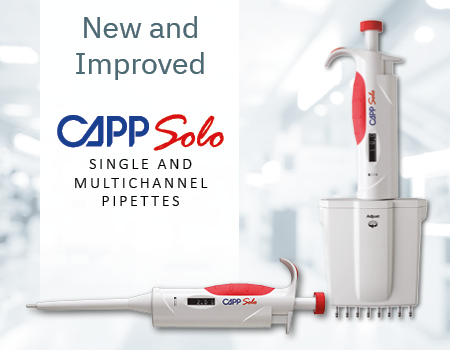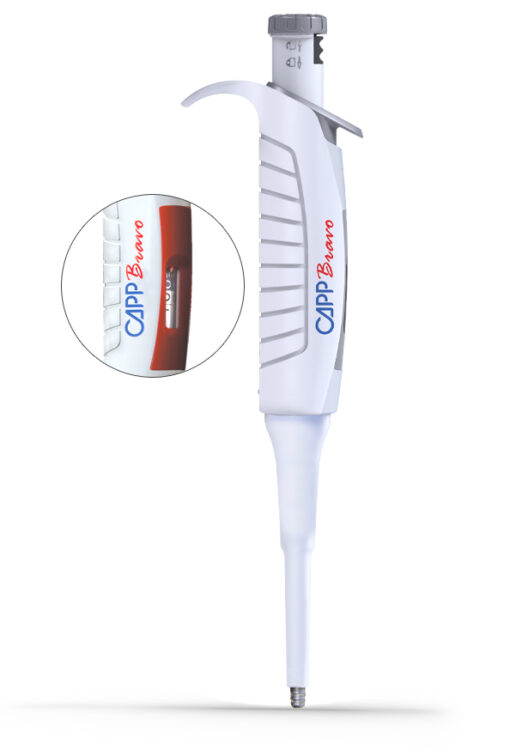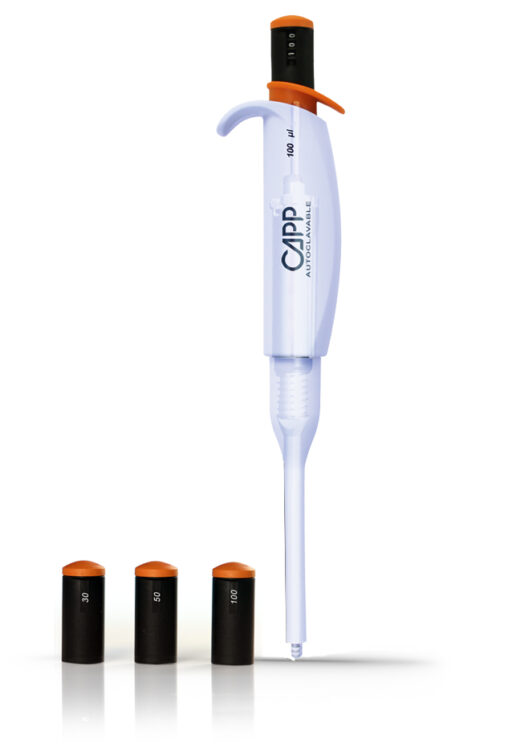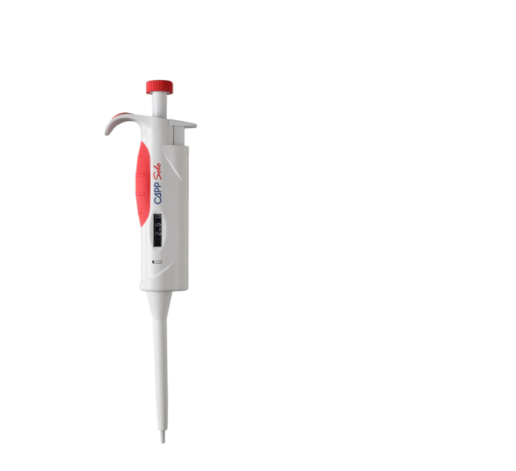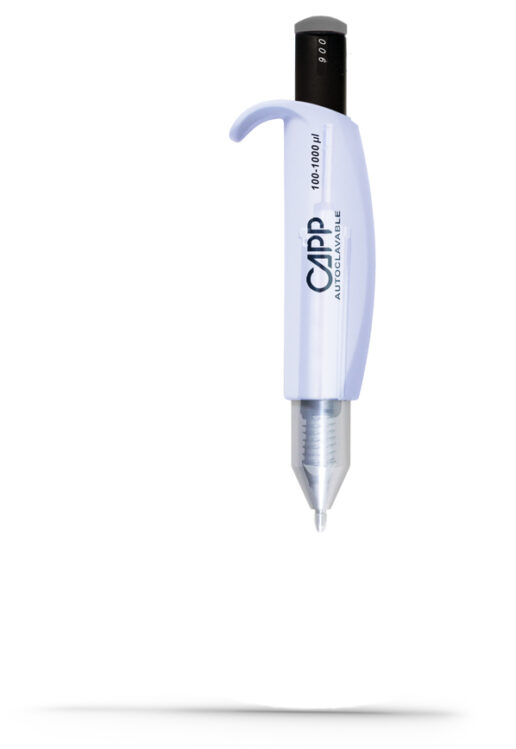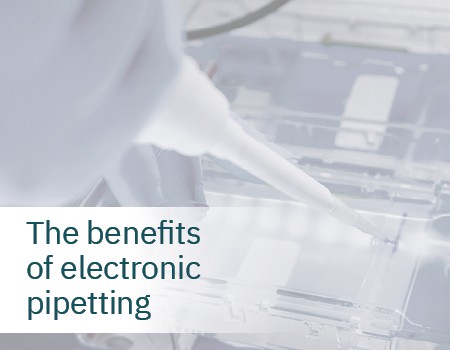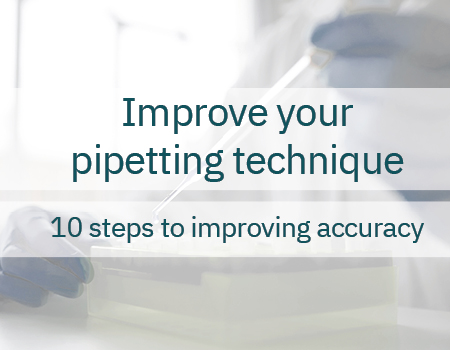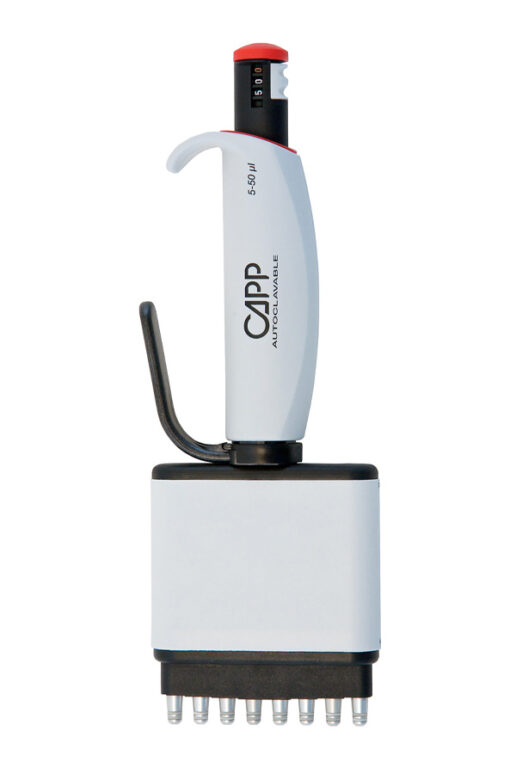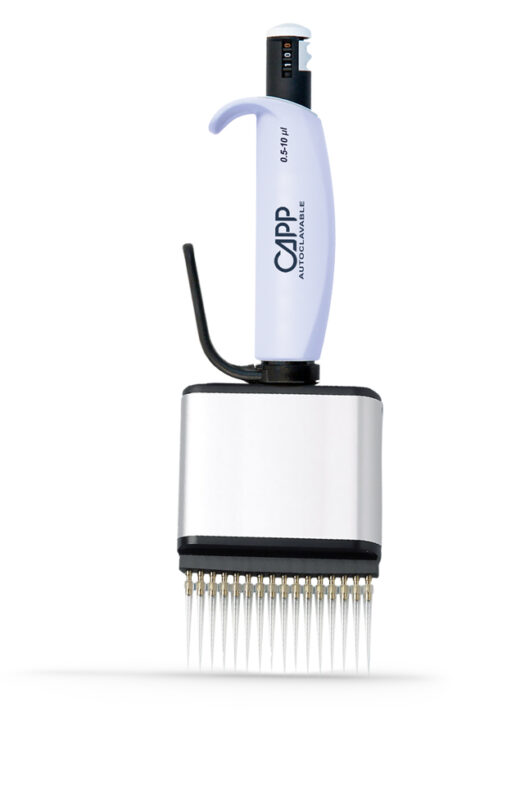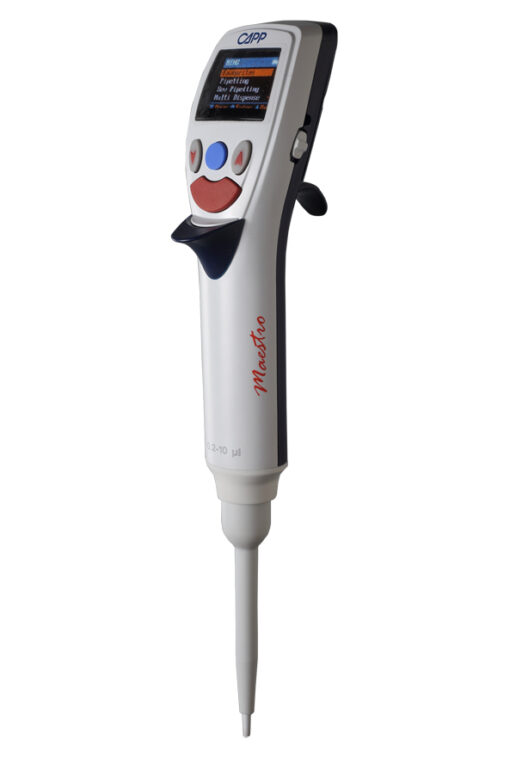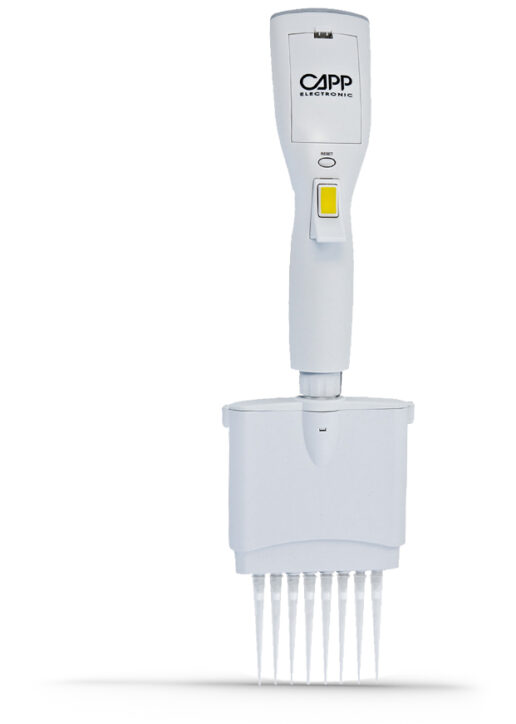CAPP Piston Pipettes – from theory to practice
Piston Pipettes: A brief history
Piston pipettes have not always been as common in life science labs as they are today. Scientists pipetted by mouth for much of modern scientific history. One scientist out of Marburg in Germany changed this in the middle of the 20th century. By modifying a syringe, Heinrich Schnitger developed the first piston pipette. Beginning with this simple air displacement pipette, manufacturers like CAPP have continued to improve the accuracy and precision of piston pipettes. We believe that modern piston pipettes have been the fuel behind the growth of life sciences in the modern era.
Air Displacement Pipettes: The basics
Among modern piston pipettes, air displacement pipettes are the most common. Air displacement pipettes feature a piston enclosed within the pipette assembly. An air cushion separates the plunger from the liquid to be transferred. With good pipetting technique, this cushion will protect your samples from contamination. In early piston pipettes, the air cushion would be affected by changes in the environment (i.e., humidity, temperature, etc.). Modern air displacement pipettes from CAPP can be used in a wide range of environments with high precision and accuracy. Additionally, air displacement pipettes are affordable and readily available.
Positive displacement: Piston Pipettes for the demanding times
Some piston pipettes use a positive displacement mechanism for transferring liquids. Although they are not commonly used for most lab work, positive displacement pipettes are great for transferring viscous liquids. The piston of positive displacement piston pipettes is in the disposable tips. Here, the piston is in direct contact with the liquid to be transferred. Positive displacement pipettes are a wonderful choice for handling viscous liquids and corrosive reagents. However, for most liquids that are handled in the modern lab, air displacement pipettes are the better choice.
Which Piston Pipette should I choose?
Selecting the best piston pipette can be challenging with a broad range of options on the market today. At CAPP, we have put in the hard work for you so that you can focus on your research while we innovate on the tools. All CAPP’s piston pipettes are manufactured to meet the rigorous quality requirements of ISO 8655 guidelines. CAPP’s portfolio also includes several air displacement pipettes and a positive displacement piston pipette for the difficult liquids. Designed for accuracy and precision, CAPP’s pipettes help you get your data out faster. In the next section, we will provide a brief overview of CAPP’s extensive range of air displacement pipettes and positive displacement piston pipettes.
CAPPBravo: The ergonomic Air Displacement Pipette
Repetitive strain injury is a leading cause of workplace injury among researchers that regularly use piston pipettes. With their lightweight design and ergonomic features, CAPPBravo air displacement pipettes lower the risk of RSI. The featherlight plunger helps you apply less force to the piston pipette. The smaller volumes of CAPPBravo air displacement pipettes also feature a metal shaft and double O-rings. These features help CAPPBravo air displacement pipettes retain their accuracy for longer periods of time and make them robust towards accidental and regular tear and wear. CAPPBravo automatic piston pipettes are available in variable volume and fixed volume options.
Ecopipette: An eco-friendly Piston Pipette
CAPP’s Ecopipette range sits as king among eco-friendly manual air displacement pipettes. This ‘green’ air displacement pipette is designed to last longer than average. Extending the lifespan of Ecopipette means fewer piston pipettes are thrown away each year. Additionally, this air displacement pipette is supplied in biodegradable packaging. Ecopipette air displacement pipettes also feature exchangeable volume counter mechanisms. These innovative counter mechanisms give this piston pipette unparalleled convenience and versatility.
CAPPSolo: Your everyday Piston Pipette
The CAPPSolo range of air displacement pipettes was created for reliable everyday use. All single channel and multichannel piston pipettes in this range are reliable and budget-friendly. CAPPSolo air displacement pipettes are designed to maintain their accuracy and precision for longer. This means that you can worry less about calibrating your air displacement pipettes every other week. CAPPSolo air displacement pipettes also feature excellent chemical and bump resistance. With their color-coded plungers, these piston pipettes are ideal for multi-tenant environments.
CAPPTrio: 3 piston pipettes in 1
CAPPTrio is the only air displacement pipette in the world with many interchangeable fixed volumes. This innovative piston pipette allows you to have three air displacement pipettes in one unit. To change volumes, simply pull out the detachable volume knob and replace it with another. With this simple volume-changing mechanism, the CAPPTrio piston pipette offers greater flexibility. Custom knobs are available in addition to the standard volume knobs of this unique air displacement pipette. The CAPPTrio piston pipette can also be fitted with a variable volume pipette for extra flexibility. Visit this page to learn more about CAPPTrio flexible volume air displacement pipettes.
CAPP Microbiology pipette: A powerful Air Displacement Pipette
Although most air displacement pipettes are not designed to handle viscous liquids, CAPP Microbiology pipettes go against the grain. These powerful piston pipettes can handle liquids such as yogurt, cream, and cosmetics without breaking a sweat. CAPP Microbiology air displacement pipettes have three fixed volume knobs designed for the most used pipetting volumes. Unlike most other air displacement pipettes, the CAPP Microbiology pipette is a straw pipette. This allows users to comfortably reach and pipette food or cosmetics with ease.
CAPPAero: Innovative multichannel Air Displacement Pipettes
If the word “groundbreaking” ever defined piston pipettes, it would best apply to CAPPAero air displacement pipettes. CAPPAero multichannel pipettes go where no other pipette brands dare to explore. The CAPPAero range of multichannel piston pipettes has industry-leading channel options that help you achieve more, faster. Scientists working with 96 well plates will love the flexibility of CAPPAero 8 and 12-channel piston pipettes. For those labs processing samples in 384 well plates, CAPPAero 16, 24, 32, 48, and 64 channel air displacement pipettes have you covered. CAPPAero air displacement pipettes also feature a unique, ergonomic tip ejection lever that does away with sore thumb overload.
CAPPMaestro: Innovative single-channel electronic Piston Pipettes
The CAPPMaestro single-channel piston pipette is a modern air displacement pipette with a full-color display. The beautiful OLED display has a high refresh rate that uses very little power for longer-lasting performance. Users can use the intuitive digital interface of the CAPPMaestro piston pipette to save their pipetting protocols. Switching between protocols is as simple as two quick and simple clicks on the piston pipette. Powered by a long-lasting lithium battery, the CAPPMaestro air displacement pipette will last for an exceedingly long time.
CAPPTronic: Electronic multichannel Air Displacement Pipette at a bargain
Designed for speed and accuracy, CAPPTronic multichannel air displacement pipettes speed up microplate workflows. And getting started with this creative piston pipette is as easy as running through a single-sided instruction manual. CAPPTronic digital multichannel piston pipettes can save up to nine pipetting protocols for faster liquid transfer. This capable air displacement pipette can be used for sequential dispensing, multi-dispensing, mixing, and reverse pipetting. A light chassis and long-lasting lithium battery make for fast and comfortable pipetting. You can learn more about the CAPPTronic multichannel air displacement pipette by visiting this link.
Test your Piston Pipettes today!
 CAPP offers a wide range of air displacement pipettes for life science laboratories. Each piston pipette in our catalog is fine-tuned for accuracy, precision, and reliability. If would like to test any of the air displacement pipettes in CAPP’s catalog, you can click here to contact our sales team. Our friendly sales team will be delighted to help you choose the best piston pipettes for your unique liquid handling workflow. Once you have selected the best piston pipettes for lab work, we will get them to you as quickly as possible. With our global network of distributors, your order of CAPP air displacement pipettes will always be on time. Choose CAPP for truly accurate, truly robust piston pipettes!
CAPP offers a wide range of air displacement pipettes for life science laboratories. Each piston pipette in our catalog is fine-tuned for accuracy, precision, and reliability. If would like to test any of the air displacement pipettes in CAPP’s catalog, you can click here to contact our sales team. Our friendly sales team will be delighted to help you choose the best piston pipettes for your unique liquid handling workflow. Once you have selected the best piston pipettes for lab work, we will get them to you as quickly as possible. With our global network of distributors, your order of CAPP air displacement pipettes will always be on time. Choose CAPP for truly accurate, truly robust piston pipettes!
CAPP mechanical pipettes are designed to offer the best user experience on the market. Each mechanical pipette in our wide portfolio is crafted for a specific usage scenario, allowing users to get the best value from their pipette investment. Packed with lots of innovative features, each CAPP mechanical pipette will give you the edge in your research or clinical practice without paying a premium. To help you understand how our mechanical pipettes work, we have created a helpful guide, answering some of our users' frequently asked questions on mechanical pipettes. As you navigate through the different sections of this page remember to click the links to explore the universe of CAPP's truly accurate, truly robust mechanical pipettes.
CAPP mechanical pipettes offer excellent ergonomics for industry-leading pipetting comfort. A contoured body provides users extra comfort when handling CAPP mechanical pipettes. Additionally, CAPP mechanical pipettes have a low thumb load to minimize the risk of repetitive strain injury (RSI) when aspirating liquids. The piston stroke on each mechanical pipette is precision engineered for smoothness and thus it also lowers the risk of RSI. CAPP mechanical pipettes also feature a robust and lightweight chassis that allows users to transfer liquids for extended periods without getting fatigued. Click here to learn more about the excellent ergonomics of the CAPP ecopipette mechanical pipette.
CAPP mechanical pipettes are designed to minimize the chances of sample contamination but when accidents happen, the pipettes are easy to clean. For routine maintenance, rubbing the mechanical pipette with water and a mild detergent will remove most contamination. Alternatively, you can use 60-70% ethanol for even faster decontamination. The external and internal materials used to manufacture CAPP mechanical pipettes are also autoclave-ready. This means that you can simply add CAPP pipettes to your autoclaving workflows for fast and effective sterilization of each mechanical pipette. To keep your mechanical pipette free of contamination we also recommend using ExpellPlus filtered pipette tips.
Most mechanical pipettes feature an adjustable volume mechanism that allows users to transfer variable volumes. Variable volume mechanical pipettes offer excellent flexibility and cost savings by reducing the number of mechanical pipets required on a workstation. However, variable volume pipettes are prone to user error, and this can reduce their accuracy and reliability in volume-sensitive applications. In such use cases, fixed volume mechanical pipets offer greater reliability as they always transfer a fixed volume of liquid with each aspiration. Fixed volume mechanical pipettes are also an excellent choice for routine protocols that require transferring a set volume of liquid. CAPPTrio fixed volume mechanical pipettes combine the best of both worlds by offering interchangeable fixed volume knobs for quick and easy switching between volumes.
When aspirating liquid samples with a pipette, push the plunger gently to the first stop and hold it there. This allows you to load the correct amount of sample without overloading the tip. Gently release your thumb from the plunger, drawing liquid into the pipette tip. Avoid releasing the plunger too quickly as this may create a pressure gradient that will force liquid into the shaft of your automatic pipette, potentially damaging it. After successfully loading the sample into a tip, keep the micropipette at a vertical angle (<15°) until you dispense the liquid. Release the liquid by gently pushing the plunger down until you reach the second stop. Follow these simple steps to draw liquid into a pipette safely.
Manufacturers usually publish data on the systematic error and random error of their pipettes. At CAPP, all our pipettes are supplied with technical documentation that specifies the systematic error and random error values of the pipette. This technical documentation is available in the packaging and can be easily accessed by visiting the CAPP website and navigating to the product page via the intuitive menu. It is important to note that systematic error may be denoted as inaccuracy while random error may be designated imprecision in some product literature. Click here to see an example of such technical information can be seen on the specification chart for the CAPPTrio fixed volume pipette available. At CAPP, we make checking the error of your pipette as easy as possible to foster an environment of transparency and trust.
The error of a pipette is an abstract concept that cannot be determined in real world pipetting environments. It is defined as the difference between the measured value and the true value. If a pipette user measures 1002 µL with their automatic pipette when they intend to measure 1000 µL, the error would be 2 µL. However, as it is not possible to accurately determine the error of a pipette manufacturers prefer to use the concept of uncertainty to approximate pipette error. Uncertainty is a probabilistic value that gives a degree of confidence that the true value of a measurement lies within the uncertainty range. Manufacturers often publish the uncertainty of a pipette on the actual device to guide users on the error of the pipette.
Systematic error can be linked to the pipette (innate) or the user. The best way to avoid innate systematic error is to purchase premium quality pipettes from reputable manufacturers. Additionally, regular servicing of your pipettes helps minimize systematic error. User-centric systematic error can be avoided by routine testing and improving one’s pipetting technique. You can test your own systematic error by pipetting ten replicates of a fixed volume of distilled water on a calibrated balance. Calculate the relative standard deviation (standard deviation expressed as a percentage of the mean) of the ten values to get your pipetting error. With this knowledge, you can then implement good pipetting technique and frequently test if your systematic error is reducing. Additional practices such as storing pipettes in a vertical position and using filter tips when transferring corrosive liquids further reduce the incidence of systematic error in your laboratory.
To calculate error for a pipette, you would need to know two values. The first is the measured value and the second is the true value. The true value of a measurement is a theoretical approximation that cannot be determined in real world pipetting operations. The measured value on the other hand is a real-world value that most likely differs from the true value. The formula for calculating error for a pipette is illustrated below. It is important to remember that this formula represents an abstract concept that is not possible to determine in the real world. However, with this formula it is possible for scientists and technicians to approximate the error for a pipette.

Another important concept to highlight is the Z factor as this is directly relevant to calculations of pipette error. Calculating pipette error depends on measuring calibrated pipette volumes. The Z factor is a conversion factor used to calculate the measured volume that a pipette transfers. This factor derives from the density of water, and it is also a function of temperature and air pressure. The measured volume is pipetted onto a balance where it is recorded in µg and this value must be multiplied by the Z factor to get the correct reading in µL. A failure to account for the Z factor in your pipette measurements may account for pipette error.
Selecting a high-quality micropipette like the CAPPTrio single channel pipette is a great start, but there are a few things that you can do to make it even better. First and foremost, only use premium tips such as CAPP ExpellPlus low retention tips that are designed to fit perfectly around the pipette cone. Additionally, always pre-wet pipette tips before transferring liquids for better accuracy. Pause for 2-3 seconds before pulling out the tip from the sample volume. Apply constant pressure to the plunger to regulate aspiration speed. Whenever possible, avoid holding automatic pipettes or tips for too long as this may cause temperature imbalances.
Calibrating your CAPP micropipette is easy and straightforward. Start by choosing a draught-free environment with relative humidity >50% and moderate temperature (15°C - 30°C; ±0.5°C). Leave your pipettes, pipette tips, distilled/deionized water (grade 3), and measuring balance in the test room for 2 hours or more before calibration. A stable environment minimizes the uncertainty of measurement. Using pre-wetted CAPP pipette tips (pre-wet the tips 3-5 times), transfer the water to a measuring boat on the balance. Each calibration round should test the volume at 10%, 50%, and 100% of the micropipette's rated capacity. Once calibrated, CAPP micropipettes are designed to retain calibration for longer.
Reading the measurements on CAPP micropipettes is easy and intuitive. Fixed volume pipettes such as the CAPPTrio display the loading volume on the plunger. Variable volume micropipettes such as the CAPPSolo range have a graduated counter mechanism that rotates as you adjust the volume settings. A little indicator icon makes it easy for users to read the measurement on the counter. Modern micropipettes such as the CAPPMaestro single-channel electronic pipette feature a full-color OLED display with easy-to-read fonts. The selected volume is displayed prominently on the screen, making it easy for users to read pipette measurements.
Mechanical pipettes are among the most frequently used laboratory instruments, and it is important to choose a mechanical pipet that will integrate well with your workflow. At CAPP we recommend selecting a mechanical pipette with excellent accuracy and precision. These two factors will make sure your liquid transfers are highly accurate and less error prone. To determine this, check the manufacturer's website for proof of independent quality certification. Next, it is important to select a mechanical pipet with excellent ergonomics such as the CAPPAero multichannel pipette. An ergonomic pipette will minimize the risk of strain or injury as you transfer liquids. Additional factors to consider include pipetting capacity, sample throughput, and liquid viscosity, among others. Scroll down to see the overview of CAPP mechanical pipettes.
Using a CAPP mechanical pipette is as easy as pressing a plunger and aspirating. Seriously, it is that easy! Start by adjusting the volume control to the required volume. Place your thumb on the plunger of the mechanical pipet, making sure to keep your hand wrapped securely around the body of the pipette. With your free hand, open the box with pipette tips and gently load a tip by pressing the nose cone onto a tip. Close the tip box and press the plunger to the first stop before lowering the loaded tip into the liquid to be transferred. Pre-wet the tip for 3-5 seconds and release the plunger gently. Once loaded, release the liquid into the desired container by gently pressing the plunger of the mechanical pipette to the second stop. Eject the disposable tip by pressing the ejector hook on your mechanical pipette.

